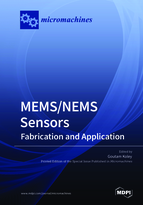MEMS/NEMS Sensors: Fabrication and Application
A special issue of Micromachines (ISSN 2072-666X). This special issue belongs to the section "A:Physics".
Deadline for manuscript submissions: closed (10 January 2019) | Viewed by 78195
Special Issue Editors
Interests: III-Nitride MEMS; chemical sensors; biosensors; 2D materials; nanoelectronics
Special Issues, Collections and Topics in MDPI journals
Interests: III-Nitride MEMS; 2D materials; nanowires; nanoelectronics; chemical sensors
Special Issues, Collections and Topics in MDPI journals
Special Issue Information
Dear Colleagues,
Due to the ever-expanding applications of micro/nano-electromechanical systems (NEMS/MEMS) as sensors and actuators, interest in their development has rapidly expanded over the past decade. Encompassing various excitation and readout schemes, the MEMS/NEMS devices transduce physical parameter changes, such as temperature, mass or stress, caused by changes in desired measurands, to electrical signals that can be further processed. Some common examples of NEMS/MEMS sensors include pressure sensors, accelerometers, magnetic field sensors, microphones, radiation sensors, and particulate matter sensors.
Despite a long history of development, fabrication of novel MEMS/NEMS devices still poses unique challenges due to their requirement for a suspended geometry; and many new fabrication techniques have been proposed to overcome these challenges. However, further development of these techniques is still necessary, as newer materials such as compound semiconductors, and 2-dimensional materials are finding their way in various MEMS/NEMS applications, with more complex structures and potentially smaller dimensions.
For this Special Issue, you are invited to submit contributions describing the development in the broad area of MEMS/NEMS based sensors, ranging from nanoscale to macroscale in dimensions and operating over a large range of frequencies from GHz to a few Hz. The scope covers different types of individual MEMS/NEMS sensors made with traditional and emerging materials employing various transduction schemes, sensor networks, multimodal data fusion; theory and applications, physical models and fabrication techniques.
Prof. Dr. Goutam Koley
Dr. Ifat Jahangir
Guest Editors
Manuscript Submission Information
Manuscripts should be submitted online at www.mdpi.com by registering and logging in to this website. Once you are registered, click here to go to the submission form. Manuscripts can be submitted until the deadline. All submissions that pass pre-check are peer-reviewed. Accepted papers will be published continuously in the journal (as soon as accepted) and will be listed together on the special issue website. Research articles, review articles as well as short communications are invited. For planned papers, a title and short abstract (about 100 words) can be sent to the Editorial Office for announcement on this website.
Submitted manuscripts should not have been published previously, nor be under consideration for publication elsewhere (except conference proceedings papers). All manuscripts are thoroughly refereed through a single-blind peer-review process. A guide for authors and other relevant information for submission of manuscripts is available on the Instructions for Authors page. Micromachines is an international peer-reviewed open access monthly journal published by MDPI.
Please visit the Instructions for Authors page before submitting a manuscript. The Article Processing Charge (APC) for publication in this open access journal is 2600 CHF (Swiss Francs). Submitted papers should be well formatted and use good English. Authors may use MDPI's English editing service prior to publication or during author revisions.
Keywords
- MEMS/NEMS Sensors
- Sensor fabrication
- Physical sensors
- Chemical sensors
- Biological sensors
- Radiation sensors








